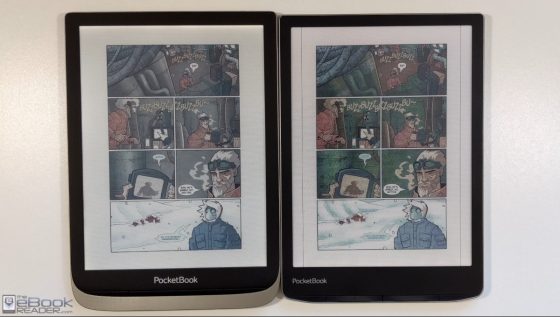I decided to buy a PocketBook InkPad Color 2 to review since it’s one of a few color E Ink ereaders on the market, and it’s a lot less expensive than Onyx’s color E Ink devices and is a good option for people that just want a color ereader and not a full-fledged E Ink tablet.
I still also have the first generation InkPad Color and I wanted to compare the differences with the screen and see if the new hardware and design are really upgrades or just more marketing hype.
PocketBook has actually managed to improve quite a few things with InkPad Color 2 while keeping the price the same. They added a warm frontlight, waterproofing, an external speaker for listening to audiobooks and text-to-speech, they upgraded to a quad-core CPU, they doubled the storage space, and the screen is a lot better in terms of color quality and text contrast.
When PocketBook announced the InkPad Color 2, I was critical of them using a Kaleido Plus screen instead of a newer Kaleido 3 screen like on the Onyx Boox Tab Ultra C and Tab Mini C, but E Ink has managed to improve their Kaleido Plus displays a lot since the first generation InkPad Color came out in early 2021.
Colors stand out a lot more on the InkPad Color 2’s screen compared to the first gen model, and there’s a noticeable difference in text contrast as well, which I wasn’t expecting. Text is visibly darker on the InkPad Color 2. There’s also a wider range of brightness settings with the frontlight—it’s not as bright at lower and medium levels, and there’s the warm option now as well.
The screen is a nice improvement, but the color grid layer is still more visible to the naked eye than it is on Kaleido 3 screens, and the resolution of color with Kaleido Plus is 100 ppi instead of 150 ppi (text is 300 ppi on both).
Another big improvement comes in terms of overall performance. The first gen InkPad Color was quite possibly the slowest ereader I’ve ever used, as I complained about in the review. The quad-core CPU on the InkPad Color 2 really speeds things up. It’s still not blazing fast by any means, but it doesn’t take several seconds for the software to respond now.
There is one notable downgrade going from the first generation to the second generation InkPad Color. The second gen version lacks a microSD card slot, but it has 32GB of onboard storage space (more like 28GB usable), double that of the first gen model.
There are some things I like about the new design and some things I don’t. First off, it’s hard to tell from the pictures, but the InkPad Color 2 has an indented screen instead of a flush screen like the InkPad 4, which shares the same design otherwise.
The new design is a bit blockier (the edges are comfortably rounded but they aren’t tapered like the first gen version) and the device is heavier overall (about 44 grams heavier), but the device has more of a premium feel to it.
I’ll talk more about this stuff in the main InkPad Color 2 review that I’ll post next week. In the meantime, here’s a YouTube video showing how the first and second gen InkPad Colors compare.


Awaiting your review anxiously. If they had added more RAM, would it have been snappier?
I don’t think it is that easy to say. After all, the original Kobo Elipsa had a quad core processor and the replacement Elipsa 2E only has a dual core processor yet is considered much faster!
The week is about to end. Any problems with the new Inkpad?
Sorry I go sidetracked with other stuff. I’ll get the review finished in another day or two.
Do you expect any update which add some refresh modes?
That seems unlikely at this point.
I am curious to know if this ereader is compatible with a Mac. I have a PocketBook which will talk to my Mac which is brilliant. Also is it possible to organize ebooks into folders?This is brilliant as I have a lot of ebooks.
So you have a PocketBook that works with your Mac and you’re asking if a PocketBook will work with Macs???